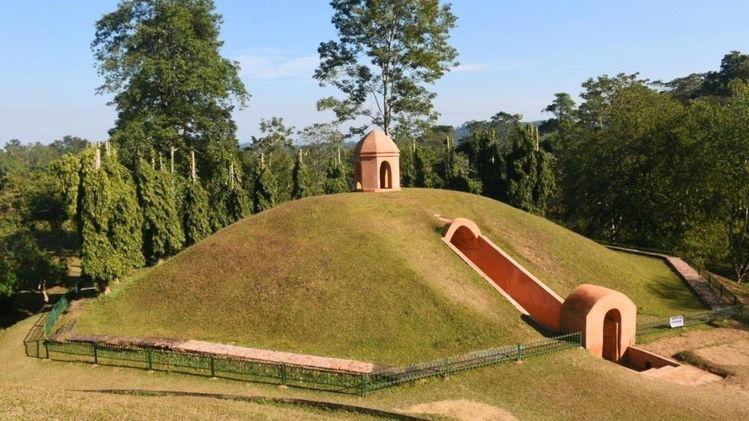The Charaideo Maidams of Assam have been inscribed as a UNESCO World Heritage Site. This monumental recognition highlights the rich cultural and historical significance of these burial mounds, often referred to as the “Pyramids of the East.” The announcement has brought pride and global attention to Assam, celebrating its unique legacy and the Ahom dynasty’s remarkable contributions.
What Are the Charaideo Maidams?
The Charaideo Maidams are a cluster of ancient burial mounds located in the Charaideo district of Assam. These maidams serve as the final resting places of the Ahom kings, queens, and nobility who ruled Assam for over six centuries, from the 13th to the 19th century. Each maidam is a hemispherical mound built with earth and stones, symbolizing both a tomb and a sacred site.
The architectural style of these maidams reflects a blend of Hindu and Buddhist influences, showcasing the syncretic culture fostered by the Ahom dynasty. The intricate designs, symmetrical layouts, and use of locally sourced materials speak volumes about the advanced craftsmanship and aesthetic sensibilities of the era.
Historical and Cultural Significance
The Ahom dynasty, founded by Chaolung Sukapha in 1228 CE, is credited with unifying Assam and establishing a powerful kingdom that withstood multiple invasions. The Charaideo Maidams not only commemorate the Ahom rulers but also encapsulate the socio-political and spiritual ethos of the time.
These burial mounds were more than mere tombs; they were believed to be gateways to the afterlife. Rituals and ceremonies performed at the maidams were intended to honor the departed souls and ensure their spiritual journey. The Ahom kings, regarded as divine rulers, were often buried with their possessions, and the maidams were guarded zealously.
Charaideo, meaning “The Hill of the Sun,” was the first capital of the Ahom kingdom. It served as a cultural and political hub, with the maidams forming an integral part of its landscape. Today, around 150 maidams remain, though historical records suggest that over 500 once existed.
Journey to UNESCO Recognition
The inclusion of the Charaideo Maidams in the UNESCO World Heritage list is the result of years of concerted efforts by historians, archaeologists, and cultural enthusiasts. Assam’s government played a pivotal role in preparing a detailed nomination dossier that highlighted the maidams’ universal value.
The recognition underscores the site’s outstanding cultural heritage, comparable to other ancient burial sites worldwide, such as the Pyramids of Giza in Egypt. UNESCO’s acknowledgment not only elevates the status of the Charaideo Maidams but also ensures global attention and efforts toward their preservation.
The Impact of World Heritage Status
The UNESCO World Heritage designation brings with it several benefits and responsibilities:
- Global Recognition: The Charaideo Maidams are now part of an elite list of globally significant cultural sites, attracting tourists, researchers, and heritage enthusiasts from around the world.
- Tourism Boost: Assam’s tourism industry is expected to receive a significant boost. The state government has already announced plans to improve infrastructure and create sustainable tourism models around the site.
- Conservation Efforts: UNESCO’s involvement ensures better funding, expertise, and international collaboration for the preservation of the maidams. Measures will be taken to protect the site from environmental degradation and human interference.
- Cultural Pride: The recognition has instilled a sense of pride among the people of Assam, fostering greater awareness and appreciation for their heritage.
Preserving a Legacy
While the UNESCO tag is a cause for celebration, it also brings the responsibility of safeguarding the Charaideo Maidams for future generations. Preservation efforts must balance tourism and cultural sensitivity, ensuring that the sanctity of these ancient burial mounds is maintained.
Local communities have a crucial role to play in this endeavor. Their involvement in conservation activities and awareness programs can help sustain the maidams’ heritage while ensuring their cultural relevance.
Conclusion
The recognition of Charaideo Maidams as a UNESCO World Heritage Site marks a significant milestone in Assam’s journey to preserve its rich history and culture. These ancient burial mounds are not just architectural marvels but also enduring symbols of the Ahom dynasty’s legacy. As the world turns its gaze to Assam, the Charaideo Maidams stand as a testament to the region’s glorious past and a beacon of its cultural future.
This achievement reminds us of the importance of preserving heritage sites, which serve as bridges between history and modernity, connecting us to the stories and traditions that define our collective identity.


